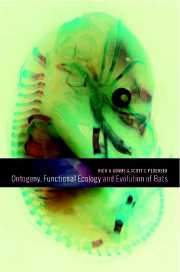Book contents
- Frontmatter
- Contents
- List of contributors
- 1 Integrating ontogeny into ecological and evolutionary investigations
- 2 Bat phylogeny: an evolutionary context for comparative studies
- 3 Early embryology, fetal membranes, and placentation
- 4 Brain ontogeny and ecomorphology in bats
- 5 Evolutionary plasticity and ontogeny of the bat cochlea
- 6 Skull growth and the acoustical axis of the head in bats
- 7 Ontogeny of the chiropteran basicranium, with reference to the Indian false vampire bat, Megaderma lyra
- 8 A theoretical consideration of dental morphology, ontogeny, and evolution in bats
- 9 Wing ontogeny, shifting niche dimensions, and adaptive landscapes
- 10 Ontogeny and evolution of the hindlimb and calcar: assessing phylogenetic trends
- 11 A comparative perspective on the ontogeny of flight muscles in bats
- 12 The ontogeny of behavior in bats: a functional perspective
- Index
8 - A theoretical consideration of dental morphology, ontogeny, and evolution in bats
Published online by Cambridge University Press: 17 August 2009
- Frontmatter
- Contents
- List of contributors
- 1 Integrating ontogeny into ecological and evolutionary investigations
- 2 Bat phylogeny: an evolutionary context for comparative studies
- 3 Early embryology, fetal membranes, and placentation
- 4 Brain ontogeny and ecomorphology in bats
- 5 Evolutionary plasticity and ontogeny of the bat cochlea
- 6 Skull growth and the acoustical axis of the head in bats
- 7 Ontogeny of the chiropteran basicranium, with reference to the Indian false vampire bat, Megaderma lyra
- 8 A theoretical consideration of dental morphology, ontogeny, and evolution in bats
- 9 Wing ontogeny, shifting niche dimensions, and adaptive landscapes
- 10 Ontogeny and evolution of the hindlimb and calcar: assessing phylogenetic trends
- 11 A comparative perspective on the ontogeny of flight muscles in bats
- 12 The ontogeny of behavior in bats: a functional perspective
- Index
Summary
INTRODUCTION
Bat dentitions have been examined intensely by many scientists, beginning with the comparative anatomists and natural historians of the 19th century. Aside from understandable curiosity about the teeth of these seemingly unusual animals, much of the original substantive work can best be explained in terms of classical taxonomy. As in most other mammals, the formulae and morphology of teeth in bats provide many characters useful in classification. Interspecies diversity in dental morphology and numbers of teeth were recognized early and bat dentition thus was examined with great care. Qualitative (and even some quantitative) data were carefully recorded and often emphasized in the early papers. The early classic monographs by Dobson (1878), Andersen (1912), and Miller (1907) offered excellent illustrations of dental morphology in a great variety of species. The quality of these pen-and-ink or wash drawings is such that time will not diminish their utility for the student of chiropteran anatomy, evolution, and systematics. Likewise, some of the conclusions and taxonomic hypotheses drawn by these early workers have stood the test of time.
Dentition and dental characters are still important to modern bat systematists. Dental character states (presence or absence of individual teeth or morphological features of crowns) figure prominently in some of the most recent attempts to posit genealogical hypotheses (e.g., Kirsch et al. 1995; Springer et al. 1995; Simmons & Geisler 1998). Sometimes, taxonomic or systematic data sets have been used to make inferences about evolutionary trends in diet.
- Type
- Chapter
- Information
- Ontogeny, Functional Ecology, and Evolution of Bats , pp. 247 - 274Publisher: Cambridge University PressPrint publication year: 2000
- 10
- Cited by



